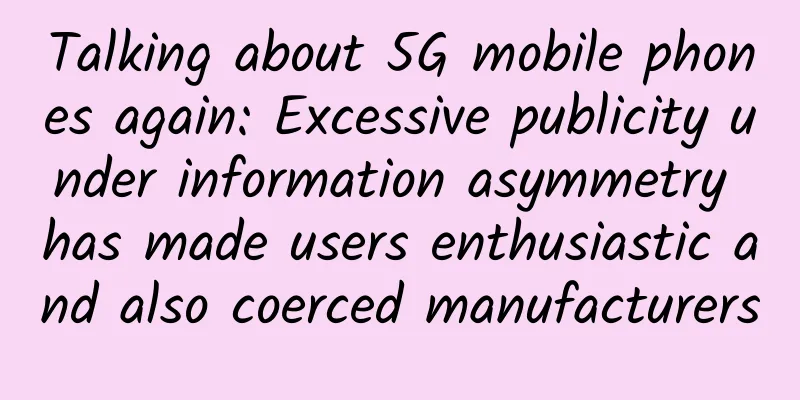Talking about 5G mobile phones again: Excessive publicity under information asymmetry has made users enthusiastic and also coerced manufacturers

|
5G technology, as an important milestone in China's transformation from following and keeping pace with the past to leading in communication technology, has long been a household name with the support of publicity from all walks of life. And observing the various aspects of 5G from the current standpoint, it is not difficult to find that this technology, which cannot be overestimated in the short term but must not be underestimated in the long term, has become a trend under the current expectations of all walks of life. From the consumer side alone, it has not only become a yardstick for measuring the technical capabilities of manufacturers, but also the core of users' entanglement in changing phones. However, suddenly promoting the various benefits of 5G technology to users based on information asymmetry, painting all kinds of big rosy pictures without mentioning the current reality of 5G technology infrastructure, and rushing users to pay for it may also backfire on the normal development of 5G, which is something the industry needs to pay attention to. 5G technology has become a yardstick for measuring manufacturers’ capabilities Looking at the smartphone industry, it is not difficult to find that 5G has become a yardstick for users to measure the capabilities of manufacturers. In the current user perception, such a mindset has been formed: whoever fails to launch 5G products in a timely manner is a laggard without innovation. Perhaps because of this, in order to seize the minds of users and shape the image of their own innovative capabilities, manufacturers have competed to announce the first 5G. For example, who was the first to send a tweet based on 5G technology, who was the first to send a microblog based on 5G network, who was the first to surf the Internet with 5G, who was the first to make a 5G off-site video call. Of course, these are the results of the manufacturers' hard work and research, and we cannot deny it, but the continuous announcement of the so-called firsts makes it obvious that it has a public relations meaning. This magic happened again on July 16. On the 16th, a reporter from the Daily Economic News found on the official website of the China Quality Certification Center that 7 5G mobile phones have obtained 3C certification. Among them, Huawei has 4 models, and OnePlus, ZTE, and vivo each have one 5G mobile phone that has obtained 3C certification. However, even such a report has attracted responses from OPPO and Xiaomi, who were not involved in the report. OPPO said, "We have obtained all the certificates, but they have not been made public yet." Then it showed the 3C certificate and announced that the OPPO Reno 5G version has officially obtained the Chinese 5G terminal telecommunications equipment access license, indicating that OPPO has all three certificates for 5G mobile phones (3C certification, network access license and wireless approval certificate). Xiaomi responded, "Xiaomi 5G mobile phone will apply for testing next week. The current 3C certification only tests 2G, 3G, and 4G functions, and there are no new 5G test items." This shows how sensitive manufacturers are when it comes to 5G products, and how afraid they are of being labeled as lagging behind in 5G technology. A more notable example is when Meizu's Huang Zhang answered a user in the Meizu community when Meizu would launch a 5G phone. He replied, "Don't worry about 5G. The initial 5G phones are bulky and heavy, and even if they only use 4G, they consume more power. We will launch 5G phones next year, but I personally think that 5G phones will be basically mature for consumers the year after next." Huang Zhang's reply has attracted the sneer of countless users and the media, who believe that this is Meizu's excuse for not having launched a 5G phone yet. 5G is the core of users' entanglement in changing phones But to be fair, is Huang Zhang's evaluation of 5G mobile phones wrong? Actually not. Judging from the current reality of 5G infrastructure, the most pertinent evaluation of 5G infrastructure construction is that it is immature and does not meet commercial requirements. Judging from the actual experience feedback from current 5G-friendly user experiences: the biggest effect of 5G at present is the improvement of download speed, but the available range of 5G services is greatly limited. Even in cities like Beijing and Shanghai, 5G coverage is still far from meeting commercial requirements. At present, Beijing's coverage is still hotspot coverage, covering key areas, and has not been fully rolled out. According to Zhang Tongxu, director of China Mobile Research Institute, at the 2019 (and the 7th) IMT-2020 (5G) Summit: "By the end of the year, China Mobile will achieve the scale of building 50,000 5G base stations in 50 cities." According to a research report by China Securities Construction Investment, it is expected that the construction volume of 5G base stations in China will reach 150,000 in 2019. It is probably difficult to support the smooth experience of 5G with this base station coverage rate. In comparison: as of 2018, China Mobile had a total of 2.41 million 4G base stations, while Telecom and Unicom had 1.38 million and 990,000, respectively. It can be said that there is still a long way to go in the construction of 5G base stations, which makes the current 5G mobile phones a bit premature. After all, it is obviously different from the 3G and 4G eras where network infrastructure was ahead of the products. 5G mobile phones that are ahead of infrastructure construction may only be suitable for geeks in first-tier cities. However, faced with this extremely obvious reality, many users remain unmoved and still believe that others telling the truth are covering up their own shortcomings and making excuses for their own backwardness. This is the fantasy of current market users. The enthusiasm of users for 5G technology has not only made manufacturers nervous, but is also backfiring on themselves. A simple example is that 5G is becoming the core dilemma for users who want to change their phones. For example, since last year, many friends have been struggling with the issue of changing phones because of the upcoming 5G, and they often consult me for advice. Indeed, the current time when 4G and 5G meet is indeed an awkward time for those who plan to use a mobile phone for several years. After all, in the reality that 5G mobile phones will be launched in the second half of the year, if you continue to buy 4G mobile phones, they may become outdated next year. It is precisely based on this that many friends still insist on waiting for 5G mobile phones to come out before changing their phones even though their current mobile phones can no longer meet their needs. But in reality, 5G mobile phones, which are ahead of infrastructure construction, cannot currently bring substantial experience improvements to users. The 5G mobile phones that users buy at a high price (relatively speaking) will become decorations and useless in most cases. As Jon Swartz of Barron’s puts it: “Like so much of the news about 5G, the hype obscures the reality.” Excessive publicity under information asymmetry: users are enthusiastic and manufacturers are also engulfed Here, we need to ask such a question: Why are users so concerned about 5G mobile phones, and think that if a manufacturer does not launch 5G mobile phones in the first place, it will be a laggard? In fact, if we trace the source, we can find that this is not because users know how much about the technical capabilities of major manufacturers, how much they know about the reality of 5G mobile phones, and how urgent the demand for 5G mobile phones is. Instead, the industry has over-hyped 5G technology and some manufacturers based on information asymmetry, causing user fans to fall into an excessive self-fanaticism about 5G technology. As we can see, most of the current 5G propaganda presents the following information to users: how advanced we are in 5G technology, and what kind of disruptive changes 5G technology can bring to us. Indeed, we are in a relatively leading position in 5G technology, and 5G technology may indeed bring about disruptive changes and progress in society. However, this kind of change and disruption is not in the present tense, but in the future tense three to five years later. However, the current propaganda has made many people think that 5G technology can bring about such disruptive changes immediately. It can be said that the media has painted a big picture for 5G technology, but has not fully presented the current status of 5G to users, blurring the actual maturity of 5G technology. This excessive publicity based on information asymmetry has fanatical users and coerced manufacturers, but in the end it may still harm the development of 5G technology. After all, the high-profile publicity has given users extremely high expectations. Once the actual experience is too far from expectations, what 5G will leave for users may be a farce of crying wolf, which is probably very detrimental to the development of 5G technology. At this point, I personally hope that manufacturers will wait a little longer for the construction of 5G infrastructure. |
<<: What does a mobile phone need to do to completely replace a PC?
>>: A brief analysis of Android drawing principles
Recommend
Is the small belly to protect the uterus and ovaries? Doctors warn: Storing too much abdominal fat is very harmful!
"Women's small belly is to protect the u...
Baidu promotion bounce rate, bidding hosting website bounce rate solution?
In this era of rapid development, if you want to ...
What treasures have humans unearthed in the past 200 years? Just look at this picture
For more than 200 years, There are countless impo...
Can wind turbines grow infinitely?
Produced by: Science Popularization China Author:...
The turtle tested positive for cholera! Can we still eat and drink it safely? !
On the evening of July 9 this year, the Wuchang D...
When will Huawei's Hongmeng operating system be released?
For Huawei, the most noteworthy product at the mo...
Which keywords are considered the key points in bidding promotion?
The first indicator for key words is the words th...
When did Audi start making new energy vehicles? The answer is 100 years ago!
It is inevitable for luxury brands to enter the e...
How did Wu Chunhong receive more than 2.62 million yuan in state compensation? What is the specific situation?
How did Wu Chunhong receive more than 2.62 millio...
SEO diagnostic analysis: How does a website that earns over 1 million yuan a year do SEO optimization?
Nowadays, it is rare to see websites that make mi...
Is less code cleaner?
In my eyes, clean code is simple and easy to unde...
"Lao Duan said: Make a box that doesn't get hot"
On November 1st, Skyworth iQiyi Ultra HD Box was ...
When it comes to obesity, boys are more concerned than girls! It makes sense...
According to statistics from the World Health Org...
Tesla and other automakers are expected to produce electric vehicles in China as policies are relaxed
Recently, according to foreign media, some of Chi...
Nokia X/Asha501 comparison experience
Although it is an Android system, Nokia X is diffe...









